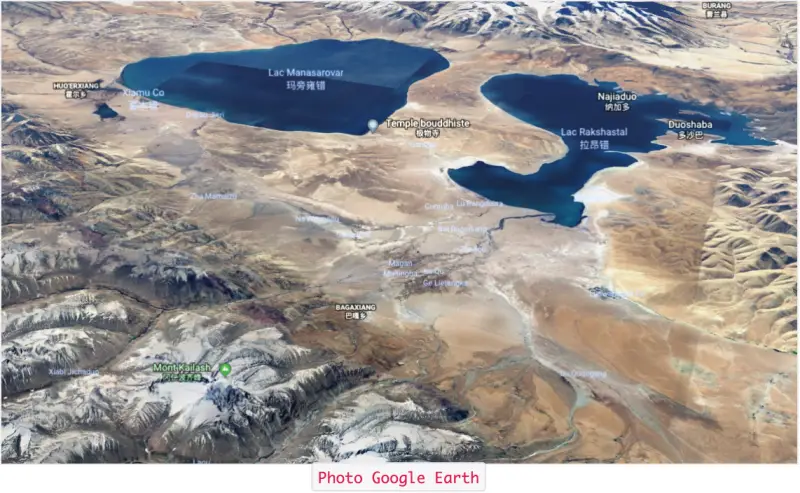Geologically, Mount Kailash was formed around 50 million years ago, while the Himalayan range developed about 10 million years ago.
The mountain is the source of four of Asia’s great rivers:
-
the Yarlung Tsangpo (Brahmaputra),
-
the Indus,
-
the Sutlej,
-
and the Karnali.
Many consider this sacred mountain to be the very heart-center of our planet, like a staircase connecting heaven and earth.

For Buddhists, Mount Kailash represents the Father Mountain, the active masculine principle of skillful means—method and action.
Accordingly, Buddhists associate Mount Kailash with the tantric meditation deities Chakrasamvara and his consort Vajrayogini (Dorje Phagmo).
Often depicted in sexual embrace, these tantric deities represent the purified aspects of human nature—especially wrathful or passionate aspects that could otherwise cause great suffering but, when properly transformed through spiritual training, can lead to true wisdom and happiness.
The sexual union symbolizes the inseparable union of wisdom and ultimate compassion, the path to achieving enlightenment for the benefit of all sentient beings.

Lake Manasarovar, serene and sacred, represents the Mother Lake, the passive feminine principle of wisdom—the understanding of interdependence and of non-inherent existence (the fundamental emptiness).

As a result, Buddhists associate Mount Kailash with the tantric meditational deities Chakrasamvara and his consort Vajrayogini (Dorje Pagmo).
Most often depicted in a sexual embrace, these tantric deities represent the purified aspects of human nature, particularly the wrathful or passionate tendencies that could otherwise cause great suffering, but which—if properly transformed through spiritual training—can lead to true wisdom and happiness.
The sexual union symbolizes the union of wisdom and ultimate compassion in order to reach the state of enlightenment for the benefit of all sentient beings.
A Mandala to Circumambulate
Mount Kailash is seen as a vast natural mandala. At its center stands a giant pillar linking our physical world to the spiritual realm and its cosmic base. The summit of the mountain is considered the primordial body of the Buddha.
The Kailash Mandala is formed of a square (the base of the mountain), with its four sides (walls) oriented toward the four cardinal directions. There are also four T-shaped gates (approaches) aligned with these directions. Each of the four sides carries its own symbolic colors and elements.
The circumambulation (kora) around Mount Kailash consists of two main routes: the inner kora and the outer kora. The outer kora, stretching 52 km in total, is the most commonly undertaken, since the prerequisites for completing the inner kora are either to first perform twelve outer koras, or to complete one outer kora during the Year of the Horse—which next occurs in 2026.

A Place of Transformation
The Kailash Mandala carries certain “reference” vibrations that activate a person’s energy centers, “tune” the physical and spiritual bodies, and greatly advance spiritual development.
Crossing the Dolma-la Pass symbolizes the transition from one life to the next, and all previous negative karma is said to be purified by Tara. It is said that no one can cross the pass without the consent of the deity, and so each pilgrim recites the mantra “Om tare tutare ture soha”, Tara’s mantra, while ascending toward the pass.
Sudden storms are common on this pass. Legend has it that if the deity does not wish to let someone through, sudden thunderstorms or herds of animals will appear to block the way.
The Kailash Kora is a place of immense energy and should not be walked in the mindset of a hurried tourist or a trekker eager to add one more trek to a long list. It must be undertaken as a practice of mindfulness, and having learned to meditate beforehand is a great advantage. This allows one to truly recognize the sensations and energies of the place. Such a mindful approach opens the door to inner perceptions that the sacred site can reveal.

“A new mountain emerges between four continents.”
This is the name of the fifth movement of Lu Jong, here performed at the foot of Mount Kailash.
Valérie Lobsang-Gattini, teacher of meditation and Tibetan yogas, regularly organizes journeys in the Himalayan regions, and 2018 marked the date of a pilgrimage to Mount Kailash.
For this occasion, anyone registering for this journey through VoyagesBienEtre.com (as soon as it is confirmed) will be offered free access to the online Kum Nyé Tibetan relaxation and yoga course in order to begin their process of integrating mindfulness and to better benefit from the Kora once on site.
How to prepare physically?
The highest point of the Kora is at 5,600 m altitude, while our arrival point in Tibet is at 3,656 m.
So, altitude issues arise as soon as we arrive in Lhasa.
VoyagesBienEtre.com ensures everything goes smoothly, and if you wish to evaluate your risks related to altitude, VoyagesBienEtre.com commits to deducting the cost of a tele-consultation with the specialist doctors of Ifremmont (Training and Research Institute in Mountain Medicine), with whom we will be in partnership during this journey.
For more details, visit the website: VoyagesBienEtre.com
Is walking mandatory?
No! The 3 days of the Kora can be done on muleback if you prefer.
The cost is about €200 to €250 for the 3 days.
The Kora of Mount Kailash is a call from the heart, a dream of a lifetime for most who make this sacred journey…
Could it also be yours?



Ajouter un commentaire
Commentaires